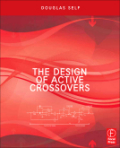
The Design of Active Crossovers is a unique guide to the design of high-quality circuitry for splitting audio frequencies into separate bands and directingthem to different loudspeaker drive units specifically designed for handling their own range of frequencies. Traditionally this has been done by using passive crossover units built into the loudspeaker boxes; this is the simplest solution, but it is also a bundle of compromises. The high cost of passive crossover components, and the power losses in them, means that passive crossovers have to use relatively few parts. This limits how well the crossover can do its basic job. Active crossovers, sometimes called electronic crossovers, tackle the problem in a much more sophisticated manner. The division of the audio intobands is performed at low signal levels, before the power amplifiers, where it can be done with much greater precision. Very sophisticated filtering and response-shaping networks can be built at comparatively low cost. Time-delay networks that compensate for phyical misalignments in speaker construction can beimplemented easily; the equivalent in a passive crossover is impractical because of the large cost and the heavy signal losses. Active crossover technologyis also directly applicable to other band-splitting signal-processing devicessuch as multi-band compressors. The use of active crossovers is increasing. They are used by almost every sound reinforcement system, by almost every recording studio monitoring set-up, and to a small but growing extent in domestic hifi. There is a growing acceptance in the hifi industry that multi-amplification using active crossovers is the obvious next step (and possibly the last bigone) to getting the best possible sound. There is also a large usage of active crossovers in car audio, with the emphasis on routing the bass to enormous low-frequency loudspeakers. One of the very few drawbacks to using the active crossover approach is that it requires more power amplifiers; these have often been built into the loudspeaker, along with the crossover, and this deprives the customer of the chance to choose their own amplifier, leading to resistanceto the whole active crossover philosophy. A comprehensive proposal for solving this problem is an important part of this book. The design of active crossovers is closely linked with that of the loudspeakers they drive. A chapter gives a concise but complete account of all the loudspeaker design issues that affect the associated active crossover. This book is packed full of valuable information, with virtually every page revealing nuggets of specialized knowledge never before published. Essential points of theory bearing on practical performance are lucidly and thoroughly explained, with the mathematics kept to an essential minimum. Douglas' background in design for manufacture ensures he keeps a wary eye on the cost of things. Features: Crossover basics and requirements The many different crossover types and how they work Design almost any kind of active filter with minimal mathematics Make crossover filters with very lownoise and distortion Make high-performance time-delay filters that give a constant delay over a wide range of frequency Make a wide variety of audio equaliser stages: shelving, peaking and notch characteristics All about active crossover system design for optimal noise and dynamic range There is a large amountof new material that has never been published before. A few examples: using capacitance multipliers in biquad equalisers, opamp output biasing to reduce distortion, the design of NTMTM notch crossovers, the design of special filters for filler-driver crossovers, the use of mixed capacitors to reduce filter distortion, differentially elevated internal levels to reduce noise, and so on. Douglas wears his learning lightly, and this book features the engaging prose style familiar from his other books The Audio Power Amplifier Design Handbook, Self on Audio, and the recent Small Signal Audio Design. It is unique; there are no other books wholly on this subject, which is increasing in relevance andpopularity *It contains never-before-published information *The author has practical experience of electronic crossover design for quantity production.
- ISBN: 978-0-240-81738-5
- Editorial: Focal Press
- Encuadernacion: Rústica
- Páginas: 528
- Fecha Publicación: 08/07/2011
- Nº Volúmenes: 1
- Idioma: Inglés
